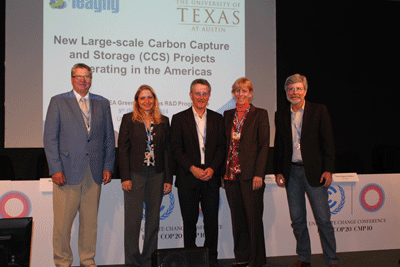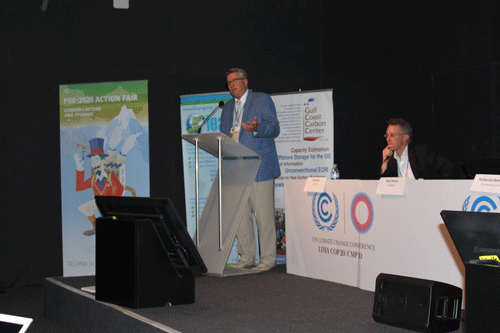 The UNFCCC Side Event on CCS Projects was held on Tuesday 9 December. Entitled “New Large-scale Carbon Capture and Storage (CCS) Projects Operating in the Americas”, it was organised by the IEAGHG with The University of Texas and CCSA. In terms of understanding the role of CCS in future climate ambitions this was a valuable event, as it included the world’s first full-scale CCS project on a coal power plant, at Boundary Dam in Canada, and Brazil’s large-scale offshore CO2 management.
The UNFCCC Side Event on CCS Projects was held on Tuesday 9 December. Entitled “New Large-scale Carbon Capture and Storage (CCS) Projects Operating in the Americas”, it was organised by the IEAGHG with The University of Texas and CCSA. In terms of understanding the role of CCS in future climate ambitions this was a valuable event, as it included the world’s first full-scale CCS project on a coal power plant, at Boundary Dam in Canada, and Brazil’s large-scale offshore CO2 management.
Katherine Romanak provided the welcome on behalf of the University of Texas. Tim Dixon of IEAGHG was the chair, and provided the introduction and context-setting, including IEA’s projections, IPCC AR5’s emphasis on CCS, and CCS developments in the UNFCCC. These developments happened when new scientific knowledge and project experiences were input to the UNFCCC processes, notably at the workshop on CCS in CDM in Abu Dhabi in September 2011 (which was followed by CCS being included in the CDM) and the recent UNFCCC ADP Technical Expert Meeting (TEM) on CCS held in Bonn. This TEM focussed on CCS project experiences, and our UNFCCC Side event built on that in looking at large-scale project experiences in the Americas. In all of these developments, IEAGHG has been active by inputting evidence-base from its technical programme. The UNFCCC provided special treatment to this event by including it in their ADP TEM ‘Fair’. This was not only good for CCS to get this hjosir-profile, but the UNFCCC also provided a TEM banner on CCS which was rather pleasing, a cartoon showing CO2 going into a locked safe (see photo).
Mike Monea of SaskPower presented on “SaskPower CCS” focussing on Boundary Dam, the world’s first commercial-scale CCS project on a coal power plant. This started operating in October, has already captured 100,000 t CO2, and it is already over-achieving anticipated performance in terms of energy penalty (less than expected), CO2 stream purity (food grade 99.9%) and the significant reductions in the other pollutants of SO2. NO, PM10 and PM2.5 . This shows so well the principle of ‘learning by doing’, with Mike emphasising that what they’ve learnt will enable them to build the next one at 30% lower cost, and his enthusiasm for the international community to visit and learn from their positive experiences. Questions included on the specifications for CO2 stream purity, whether the amine capture would work on biomass energy plant (yes), the finance and economics, and the benefits of being the world’s first project.
Paulo Negrais Seabra of Petrobras presented on Petrobras’ Offshore CO2 Management using the Pre-salt development. It is impressive in many aspects that Petrobras are undertaking this activity. Firstly that they decided to do the CO2 separation and injection so that the CO2 is not vented. Then, that they do it in such deep water conditions of 2000m and then 5000m beneath the seabed. And also the quantities of CO2 involved. Thick salt layers separate the carbonate oil reservoir into which they are injecting from the seabed (hence the name). The natural gas they are extracting has 8-20% CO2. This is separated with a membrane technique (smaller footprint which is important offshore, simple to operate and maintain, copes with a range of CO2 concentrations). The CO2 stream which is re-injected is 30-70% CO2, the rest being natural gas. CO2 injection started in 2013 and has reached around 1Mt so far, and is used with water injection for EOR. Because of the water depth, operations are undertaken from a tethered floating vessel called a FPSO (floating production storage and offloading unit). Questions was asked about the future quantities to be injected.
Vanessa Nunez-Lopez of the University of Texas Gulf Coast Carbon Centre presented on USA Large-scale Onshore Projects, covering the operational projects (six large-scale injections underway) and planned projects in the USA, focussing more on those that the University of Texas are directly involved in. Her presentation showed how EOR activities facilitate the infrastructure needed for CCS, for example Denbury’s 325 miles of Green pipeline which is now taking to the Hastings oil field anthropogenic CO2 from Port Arthur and soon from Lake Charles.
Katherine Romanak of the University of Texas Gulf Coast Carbon Centre (GCCC) presented on a Global Offshore Demonstration Project. This is a concept initiated by the USA and GCCC, and being investigated using a new task force set up by the Carbon Sequestration Leadership Forum, which will report in 2015. Katherine showed the global potential for offshore storage, offshore activities so far, and described plans for an international workshop on this topic. She included how countries could potentially use the UNFCCC’s Technology Mechanism to assist with their involvement. Questions were asked about the benefits of offshore CO2 storage including public perception, and on regulations.
Tim Dixon concluded the session by reminding the audience of the IEA’s and IPCC’s messages on the need for CCS deployment, and hoping that the ADP delivers a good climate agreement at the COP in Paris next year. CCS is not ‘science fiction’ but ‘science fact’, as demonstrated by these presenters and their projects.
This event had an interested and positively-engaged audience from many countries including USA, UK, Japan, Australia, Peru, Sudan, Turkey, and Saudi Arabia.
Presentations
New Large-scale Carbon Capture and Storage (CCS) Projects Operating in the Americas
SaskPower CCS Conference of the Parties
Petrobras’ Offshore CO2 Management – Pre-salt DevelopmentManagement – Pre-salt Development
USA large scale onshore projects/Global offshore demonstration project





